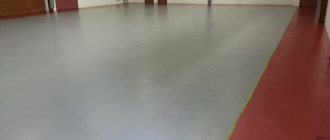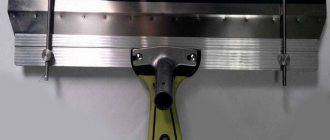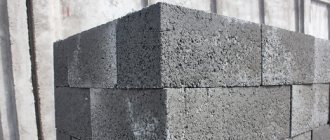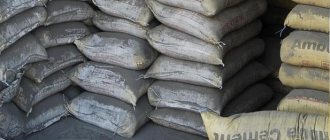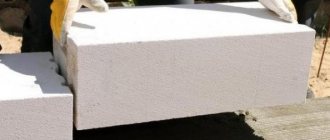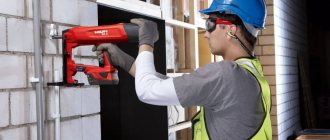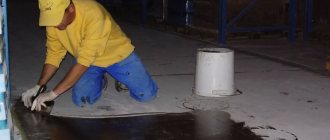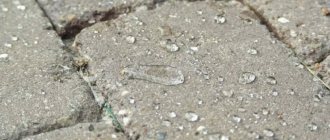Concrete is a very durable material. It copes well with adverse weather conditions and high loads. But concrete is not able to resist such a destruction process as surface abrasion, which results in the formation of cement dust on the floor surface. To combat this phenomenon, special impregnating compounds are used.
Why strengthen concrete?
The vast majority of industrial floors are made on the basis of concrete and cement-sand mortars. With all the abundance of advantages of such materials, constant exposure to air, aggressive chemicals, water, mechanical and temperature loads slowly but surely provoke the destruction of the front layer.
In addition, concrete is susceptible to carbon dioxide corrosion, which leads to dust. During operation, the strength of the screed decreases and we see potholes, chips, and cracks on the surface .
Elimination of salts on the concrete mass ensures the absence of dust
To eliminate all negative factors and obtain dust-free, durable and strong foundations, hardening impregnations for concrete are used. Modern technologies make it possible to stabilize the surface. As a result, the possibility of the formation of cracks and defects is minimized, and the salts present in the concrete matrix are bound. Elimination of salts ensures the absence of dust.
I can say that hardening impregnations demonstrate high penetrating ability. They successfully bind concrete, provide rapid polymerization, high wear resistance, low abrasion and protect the surface. If we talk about industrial floors and other critical structures, they require mandatory high-quality treatment with such compounds.
Areas of application
Despite the fact that concrete is strong, there are many micropores in its structure: moisture penetrates into them, which subsequently destroys the material. Depending on the density of the concrete, the deterioration process may only take a few years.
To make the base more durable and resistant to external influences, impregnations are used. These are special sealing materials. They increase strength, resistance to negative factors, strengthen the base and improve its appearance.
Such impregnations can be used not only for floors, but also for walls, ceilings, and other structural elements. They are used not only in warehouses or industrial premises, farms to increase the mechanical strength of the structure, but also in shopping centers, exhibition halls, and administrative buildings.
The difference between such compositions and additives is that they cover a ready-made base, and are not added to the cement mortar.
What is hardening impregnation for concrete?
Concrete hardeners are chemically active compounds on an organic or inorganic basis. They ensure tightness and effectively prevent dust formation . Concrete processed using the technology does not collapse under loads. Plus, this type of impact perfectly and quickly restores worn-out and old concrete foundations.
Reinforcers are recommended for use in warehouses, retail premises, production shops, garages, car service centers, hangars, wood processing enterprises, mechanical engineering, machine tool manufacturing, chemical industries, medical institutions, and printing houses.
Treating floors with impregnations is a prerequisite for production in the pharmaceutical and food industries , where it is necessary to prevent contact of cement dust with the manufactured product.
Treated concrete acquires the following properties:
- hardening;
- multiple increase in wear resistance;
- ensuring moisture resistance, water resistance;
- complete dust removal and protection from subsequent dust formation;
- increasing service life;
- reducing the cost of installing finishing coatings.
In addition to resistance to mechanical loads, wear resistance, impact resistance, and dust removal, we can talk about a significant acceleration in the time it takes to put a facility into active operation. This is an important factor in modern construction conditions. Concrete with a hardener is produced in one working pass . Impregnations provide high productivity - from 500 sq.m. per day. The bases are ready within 72 hours.
Thin-layer polymers. The essence is in the name
There are 2 ways to quickly assign an “impregnating” material to this class. The first is to pay attention to the name of the material, because... many manufacturers call
materials based on production needs. And only then do they adjust the name of the material to the market. So names of materials appear such as: “...-PU... (polyurethane)”; “..EP...”, “Ep...” (epoxide); “...XV...” (vinyl chloride).
The second method of recognizing a thin-layer polymer is applicable to almost all “impregnations” - this is a careful study (by description or in negotiations with the supplier) of the chemical composition of this “impregnation”. If only the composition (explicitly or as part of the material) mentions any organic substance (polyurethane, epoxy, acrylate and metaacrylate, PVC, polyester, etc.), with a high degree of probability this “impregnation” can be classified as primers or varnishes . The remaining indirect characteristics are described above and mainly relate to penetration, hardening and chemical resistance.
Classification
Inorganic substances are able to penetrate into the structure of the surface layer . As a rule, they are based on sodium and potassium compounds and are deeply embedded in the concrete body.
Materials capable of strengthening concrete are divided into organic and inorganic, depending on their composition. It is the latter type that is considered the best strengthening impregnations
Epoxy varieties are used much less frequently, since silicates provide better final concrete characteristics. For the same reason, polyurethane impregnations are not used so often. However, for an overview of all types of hardeners, it makes sense to consider them too.
Main types of strengthening impregnations:
- silicone (silicon, organosilicon) - based on sodium, magnesium, potassium fluorosilicates, colloidal polysilicates);
- lithium - based on lithium silicates. Essentially, this is a type of silicon impregnation, but in our market they are positioned as a separate group;
- epoxy – based on epoxy resins;
- polyurethane – in this case we mean the use of polyurethane varnishes (water-based).
Lithium concrete hardeners with anti-contamination properties
Lithium impregnations are a modern product specially designed for harsh operating conditions. They can be used two days after laying concrete, which is not available to some very popular analogues.
The main purpose of lithium strengthener is compaction, strengthening, hydrophobization
The material helps improve the characteristics of the finishing layer, reduces water absorption, and provides protection against dirt.
Specifications
| Name | Technical specifications |
| Appearance | Colorless, opalescent liquid |
| Active component content, % | 7 |
| Content of organic volatile substances, % | 0 |
| Density g/cm3 | 1.06 |
| pH | 10.5 |
| Dry residue, % | 7 |
| Boiling point, C | 100 |
| Solubility in water | Completely soluble |
| Viscosity | 10 mPa*s |
| Freezing temperature, C | 0 |
Advantages:
- lithium impregnations are of the latest generation; they do not give an alkali-silicate reaction. The base eliminates the risk of forming a network of small cracks;
- increase in concrete wear resistance by 20-50%;
- increase in compressive strength by 10-30%;
- increase in peel strength by 25-75%;
- dust removal;
- strengthening and protection of old and new concrete;
- lithium impregnation works when constructing street areas, paths, etc.;
- an appropriate alternative to toppings;
- bio-, fire protection;
- moisture resistance.
Flaws:
- Perhaps the only negative is the high price. This is typical even for products from domestic manufacturers.
Silicate impregnations for outdoor concrete
In this case we are talking about water-based silicate polymers. Such materials are non-flammable, non-toxic, odorless and explosion-proof. Silicate hardeners are economical and work both indoors and outdoors. The composition can be applied to freshly laid and dry concrete . One impregnation is sufficient for the entire service life. No film susceptible to abrasion is formed on the surface of the base. Concrete stops dusting and acquires a soft velvety shine.
Scope of application: open areas, warehouses, production workshops, parking lots, garages, shopping centers, markets, areas with high traffic and pedestrian load.
The average consumption of silicate impregnation is 0.14-0.35 l/sq.m. The final consumption depends on the roughness and porosity of the concrete
Specifications
| Name | Technical specifications |
| Appearance | Liquid without color |
| Active component content, % | 6 |
| Content of organic volatile substances, % | 0 |
| Density g/cm3 | 1.05 |
| pH | 11 |
| Dry residue, % | 6 |
| Flash point | Nonflammable |
| Freezing temperature, C | 0 |
Advantages:
- easy application in one step;
- no efflorescence;
- unlike lithium analogues, no flushing is required;
- high strength;
- Possibility of use on concrete with previously applied hardeners, rubbed, untreated bases.
Flaws:
- In general terms, such impregnations cause an alkali-silicate reaction. If there is silica in the concrete filler, it will lead to internal stresses. This causes cracking. A network of small cracks or large cracks (“card” cracks) may appear on the base. The defect can appear either after a couple of days or after several years;
- When working on concrete, the material absorbs moisture rather than repels it;
- the reaction with concrete may not occur completely, so that lime agglomerates may remain over the entire surface.
Reinforcers based on PVC resins
Such materials demonstrate versatility and ease of application. Concrete and concrete floors receive wear resistance and minimal abrasion, dust removal and hardening. The compositions work on old and new substrates, including low-grade concrete.
Organic-based liquid hardeners are designed to protect against increased transport and mechanical loads, and from aggressive environments . The peculiarity is that the composition can be applied at subzero temperatures.
Scope of application:
- strengthening of bases before applying polymer coatings;
- protection of floors from high shock and mechanical loads;
- hardeners are effective in car service centers, parking lots, parking lots, open areas, warehouses, markets, wholesale warehouses, terminals, utility rooms and production workshops, in the food industry (refrigeration plants, breweries, meat processing plants).
The penetration depth of PVC resins is up to 5 mm and above. Consumption – 0.2-0.35 l/sq.m.
Specifications
| Name | Technical specifications |
| Impregnation basis | PVC resin |
| Mass. share of non-volatile substances, % | 8-13 |
| Viscosity, s | 12 |
| Drying time up to 3 tbsp., h | 1 |
Advantages:
- high adhesion;
- a hardened surface with high hardness is formed;
- quick restoration of old and worn foundations;
- resuscitation of surfaces that at first glance require complete dismantling;
- the composition penetrates inside the artificial stone, causing a chemical reaction. High-strength crystalline compounds are formed in the concrete matrix, which causes effective strengthening;
- versatility - you can work in any type of premises, be it in winter or in summer.
Flaws:
- tendency to become dirty;
- low resistance to negative temperatures.
Water-based acrylic hardeners
Water-based polymer acrylic impregnations are capable of penetrating deeply into the capillary-porous structure of concrete.
The composition interacts with the components of the artificial stone and forms insoluble thread-like crystals - they fill the microcracks, pores and capillaries of concrete.
As a result, the base is strengthened and dusting and surface destruction are prevented. Strengtheners work on concrete not lower than M200. They are not effective on lower grades.
Scope of application:
Acrylic impregnations are used to strengthen industrial concrete floors and for the installation of household concrete screeds. The material is effective for preparing bases for laying finishing coatings, including polymer ones, in office premises. Strengtheners are characterized by hydrophobic properties and can work in conditions with high humidity and where high hygiene is required.
Used where department stores, consumer service facilities, supermarkets, production workshops, wholesale depots, warehouses, wet shops, pharmaceutical, food industry, parking lots, terminals, parking lots, car services.
Penetration depth – up to 1 mm or more. Consumption – 0.2-0.35 kg/sq.m.
Specifications
| Name | Technical specifications |
| Mass. share of non-volatile substances, % | 22.0-27.00 |
| Viscosity, s | 15 |
| Drying up to 3 tbsp., hours | 1 |
Objects of application: outside and inside public and industrial facilities
Advantages:
- strengthening of concrete by 1.5-2 times;
- the composition is effective on old and new substrates;
- without smell;
- high penetrating ability;
- dust removal;
- hydrophobic layer;
- environmental friendliness;
- versatility, ease of application.
Flaws:
- storage and transportation are possible at temperatures not lower than zero degrees, which limits the possibilities of application;
- the effectiveness of impregnations lasts 2-3 years, after which an update is required;
- scanty penetration depth - about 1 mm.
Epoxy based reinforcers
Epoxy impregnations are two-component aqueous compositions based on epoxy resins.
The material works on fresh or old concrete, including application on damp substrates..
If the hardener is introduced into fresh concrete, it contributes to better corrosion resistance, frost resistance and better aging. It is this solution that works well in combination with epoxy self-leveling floors.
This solution can be called optimal for food industry workshops, freezers, refrigerators, and medical facilities.
Specifications
| Name | Technical specifications |
| The basis | Epoxy resins |
| Impregnation depth | 1-2 mm |
| Mass. proportion of non-volatile substances (component A/B) | 98/45 % |
| Viability | 4 hours |
Advantages:
- strengthening of concrete 2-3 times;
- increasing hardness, preventing crack formation;
- protection from the aggressive effects of fuels and lubricants, water, solutions of salts, alkalis, acids;
Flaws:
- hardeners are inferior to analogues in terms of resistance to chemical and mechanical stress;
- low UV resistance limits outdoor use;
- small penetration depth - 1-2 mm.
Epoxy impregnation ensures concrete resistance to chemicals, removes dust, gives high strength, impermeability to moisture and other compounds
Polyurethane concrete hardeners
Polyurethane hardeners can be of two types - simple and deep penetration. In the first case, the composition penetrates into the concrete to a depth of 2-3 mm, in the second - 4-5 mm or more. It is worth noting that deep penetration impregnations are two-component and can work on concrete with high humidity and weak concrete of the M150 brand , which distinguishes this type. But here you should prepare for higher consumption.
Both materials are intended for treating substrates indoors, outdoors, and under a canopy. Impregnations are used in warehouses, terminals, garages, production shops, retail, exhibition halls, refrigerators, freezers. Plus, polyurethane is in demand in the food industry, healthcare, and nuclear energy.
Specifications
| Name | Technical specifications |
| The basis | Polyurethane polymers |
| Mass. proportion of non-volatile substances | 50% |
| Viscosity | 15 s |
| Penetration ability | 2-6 mm |
| Film strength upon impact/bending | 50 cm/1 mm |
| Hazard Class | No |
| Gloss level | Glossy |
| Coating hardness | 0.4 |
Advantages:
- multiple increase in the grade strength of concrete;
- increase in wear resistance by 8-10 times;
- the impact resistance of concrete is doubled;
- waterproof, airtight, resistant to aggressive substances;
- complete dust removal;
- quick application.
Flaws:
- if the base will be operated at sub-zero temperatures, an additional anti-slip impregnation is applied;
- the material works only on mature concrete;
- when used outdoors, a waterproofing layer is required;
- One-component formulations are not effective on wet substrates.
Fluat-impregnation for concrete strengthening
Fluidating impregnations for concrete are very economical. This is a non-flammable material suitable for indoor and outdoor use. We can confidently say that there is an increase in strength, dust removal, and an increase in the chemical stability of bases. Fluat successfully resists the formation of cracks .
Such compositions are used for economical impregnation of concrete bases of warehouses, storage facilities, garages, production workshops, on open concrete sites, runways, and airfields. It is worth noting that the impregnation works on new and old substrates, penetrating into the thickness to a depth of 5 mm or more.
Fluates do not have a corrosive effect on fittings
Advantages:
- increase in strength by 30-50%;
- improvement in wear resistance by 10-12 times;
- non-flammable;
- protection from moisture, chemicals, oils;
- does not wash out from concrete, applied once;
- vapor permeability;
- increased frost resistance;
- operating temperature -60+80 degrees.
Flaws:
- low efficiency on low-quality, very old concrete, on freshly laid concrete up to 10 days old.
The term "impregnation". Physical meaning. Relationship between the effects of “penetration” and “hardening”
The term “impregnation, impregnating composition”, perhaps, appeared in Russia at the very end of the 20th century with the appearance on the Russian market of the Ashford Formula material produced by Curecrete Chemicals (USA). The words “impregnation, impregnating composition” mean that the liquid material, after it is applied to the surface, does not remain and polymerize on it, but “penetrates” into the base, “impregnating” it to a certain depth. Concrete penetration means that there is no film on the surface of the concrete. In this case, the material is either capable of strengthening concrete to the depth of penetration, or performs another function (for example, waterproofing).
Recently, the term “impregnation” has been assigned to penetrating compounds with the effect of hardening the surface layer - and not by chance. As will be shown below, it is the presence or absence of the effects of “penetration” and “hardening” in the material that quite accurately characterizes the class of liquid materials that the manufacturer/seller calls “impregnation”, trying to use this, recently popular word, to attract additional customers.
Technology of applying epoxy impregnations
The material is applied to concrete of a grade not lower than M200. The humidity of the base should not exceed 4% by weight. Relative humidity is standardized no higher than 80%. Epoxy impregnations are applied to mature concrete (aging for at least 28 days); they work much less frequently on fresh substrates .
The air-to-base temperature should be 3 degrees above the dew point; base, air - +5-25 degrees; impregnation - +15-25 degrees.
Preparation
The top loose layer is removed from the base, for which grinding machines and hard brushes are used. The working mixture also requires preparation - both components are mixed and processed with a construction mixer. The result should be a homogeneous composition, which is left for several minutes to allow the entrained air to escape.
Application
Before applying the impregnation, the concrete is dedusted using an industrial vacuum cleaner. The composition is applied with rollers or brushes, working “crosswise”, controlling the formation of puddles. As a rule, 1-2 layers are implemented. It is necessary to observe layer-by-layer drying for 16-24 hours. Average consumption is 220-500 g/sq.m.
Tools,
High-quality implementation of work requires the use of special equipment and tools.
Equipment for preliminary preparation of concrete:
- grinding machines - for large volumes of work, high-performance equipment with a power of up to 3100 W should be used. Such a tool is durable and will allow you to quickly carry out the entire range of preparatory activities;
- shot blasting, sandblasting machines – they work on concrete with high-performance machines with a hopper volume of at least 25 liters. Plus, you will need a compressor to connect. The average cleaning performance of professional devices is 5-10 sq.m/h;
- hard screed brushes;
- industrial vacuum cleaners - the equipment must have high suction power - not lower than 255 mBar. For large areas, a good volume of garbage bin - 50 liters - will not hurt. The brush of the machine must be strong and fit tightly to the floor;
- hand grinder - in some cases you cannot do without a compact tool. They work in hard-to-reach areas and at junctions. ;
- construction mixer - effective models with a power of 1400 W, capable of working in forward and reverse motion. Speed 430-700 rpm.
Painting tools:
- brushes – work on concrete with professional brushes based on synthetic bristles. This tool is suitable for applying any impregnation. It is necessary to choose only high-quality samples that do not leave lint;
- rollers - in the case of impregnations (epoxy, acrylic, urethane, etc.), wear-resistant rollers with medium or short pile (based on velor or sheepskin) work well;
- spray guns – for professional application of materials, multi-purpose professional spray guns with a pressure of at least 2 Bar and an air flow of 300-350 l/min are used.
Even a small hand-held device for working with concrete must be powerful - at least 700 W, with a grinding speed of 3000-4500 rpm
Means of protection:
- respirators;
- workwear;
- safety shoes;
- glasses;
- gloves.
Technology of applying polyurethane impregnations
The material requires compliance with some recommendations. The humidity of the base by weight should not exceed 4%, relative air humidity – 80%. The concrete must be mature, cured for at least 28 days. The air and base temperature should correspond to -30+25 degrees, the air-base temperature should be 3 degrees above the dew point, the material temperature should be +10 degrees.
One-component polyurethane impregnations are ready for use, two-component ones are mixed in accordance with the manufacturer’s recommendations
Preparation
The base must be cleaned by grinding, sandblasting or shot blasting. In hard-to-reach areas, for example, along junctions, it is permissible to use a hand-held grinder. The resulting sludge is swept away with brushes, and the surface is additionally dusted with a construction vacuum cleaner.
If it is necessary to obtain a filler pattern, grinding is carried out in several stages : coarse grouting 3-5 mm, medium, fine, where fine grain is used. If the base requires repair, it is carried out after closing the pores before applying the finishing layer.
Application
Polyurethane impregnations are applied until the concrete is completely saturated. This can be easily observed by visual inspection - a uniform gloss should form on the surface. The formation of puddles is unacceptable. If unimpregnated areas are identified, they are covered again. If required, additional primer is applied.
Fluate application technology
The material is applied to concrete that has been cured for at least 14 days. The temperature of the base and air is +5 degrees, the humidity of the base is not higher than 7% by weight. Air humidity is not standardized. For impregnation, chemical impregnation for concrete is used - fluate and water-based acrylic impregnation for sealing.
Preparation
The top loose layer, dirt, and oils are removed from the concrete. Use a grinder or brushes. The pores of the base must be open . The resulting dust is removed with construction vacuum cleaners. Fluate chemical impregnation is diluted with water (3 liters of water per 1 liter of concentrate) - average consumption 1 liter/sq.m. Acrylic - diluted 1 liter per 1 liter - average consumption - 0.3-0.4 l/sq.m. for 2 layers.
Tools and equipment used: brushes, rollers, grinders.
Application
First, treatment is carried out with diluted fluate. The finished composition is poured onto the concrete and evenly distributed with brushes. After 15-30 minutes, the composition should be redistributed. Material should not pool . Exposure – a day.
Next, the acrylic composition is applied with rollers, working in a criss-cross manner. If required, an additional layer is distributed. Layer-by-layer drying takes 1-1.5 hours. After 24 hours, you can walk on the base. Full load is permissible after 3 days.
Technology for applying strengthening impregnations based on PVC resins
Work on applying impregnation is preceded by preliminary preparation. Surfaces must be cleaned of all dirt and remnants of old coatings. The material cannot be applied to cement laitance, as this will prevent penetration into the thickness of concrete. Sanding, sandblasting or shot blasting are used for cleaning and preparation.
Tools used : brushes, rollers
The average consumption of reinforcing impregnations based on PVC resins is 0.2-0.35 liters per sq.m.
Application
The impregnation is distributed over a dry, cleaned base. If uneven absorption is detected, it is recommended to apply another layer. Work is carried out at a temperature not lower than – 20 degrees. Drying time – 3-6 hours.
Technology for adding water-based acrylic hardeners
Concrete treatment can be carried out a day after pouring the concrete floor (in general, the exposure time depends on the manufacturer’s recommendations). The composition is applied at a temperature not lower than zero degrees. The work uses brushes, rollers, and paint sprayers. The hardener is applied in 1-2 layers. Do not allow the formation of a varnish film on the surface . Drying time – 3-6 hours, operating temperature – -40+80 degrees.
When the hardener is applied and dried, grinding is carried out. This is necessary to ensure high adhesion to the finish coating. Water is used to clean the instrument.
Introduction
Interest in impregnating compositions for concrete in Russia appeared in the late 90s of the 20th century against the backdrop of the arrival of Western (European and American) methods for constructing concrete floors in Russia.
The pioneer of advanced technologies of that time can be considered vacuum technology, better known in Russia as “Tremix technology”, after the name of the manufacturer of a set of equipment for this type of work. Vacuum technology uses a liquid composition to finish the surface of the new floor, protecting the concrete from premature loss of moisture. But companies offering this composition do not call it impregnation. The construction market of that time (at the end of the 90s) required an inexpensive material that could eliminate dust from old and new concrete floors. The vast majority of old, rather worn-out concrete floors were used; therefore, the Ashford Formula material, which appeared on the Russian market at the end of the 20th century, was considered practically as a “green pill” for all problems associated with dust.
Technology for applying lithium hardeners
To achieve maximum hardening, the maturity of concrete should be 28 days. If the material is laid on fresh concrete, then the work is carried out immediately after grouting and cutting the seams. The average consumption is 0.10-0.20 l/sq.m.
Equipment for preliminary preparation and application:
- Low pressure sprayers (pump type) - professional machines are used to ensure stable results. The use of an airless type is not necessary. After work, the equipment is washed with water;
- rotary scrubber dryers - in this case, a large wet-abrasive application is carried out. They operate with equipment with a rotation speed of 175 rpm. The attachments used are brushes with soft polymer bristles and pads;
- washing vacuum cleaners with a flat rubber nozzle - equipment is used to remove wet deposits after sanding and rinsing the base with water;
- Large brushes with nylon bristles are used to distribute the hardener after application ;
- grinding machines with diamond segments, polishing discs with a reduced degree of grit.
Preparation
Surfaces not involved in work are protected from dirt, splashes, and contact with equipment. The work area is overlapped and divided into separate zones. Seams, columns, walls and other structures are used as reference points.
Wet concrete is dried until the pores are free of water . At high humidity and low temperatures, drying is increased. Next, the concrete is polished to a degree of 80-200 grit. After grinding, the surface contaminated with fats, oils and other substances is thoroughly cleaned.
Preparation of material:
- if the concrete is hard, high-strength, bladed lithium hardener can be diluted with water in a 1:1 ratio;
- on medium-hard concrete they work with impregnation diluted to a degree of 1:0.5;
- on weak and porous bases they work with a composition of maximum concentration, that is, undiluted.
After applying the hardener, it is necessary to ensure that the composition remains in liquid form on the base for 30 minutes
Application of lithium hardener
Sequencing:
- the material can be applied by pouring, after which it is rubbed into the concrete with brushes;
- If the impregnation is applied to the surface by spraying, use a large brush with soft nylon bristles for thorough distribution. Use a tool to rub and distribute the composition;
- if a scrubber dryer is used, the material is applied to the surface by pouring and rubbed in with soft brushes or pads.
If dry zones form, additional impregnation is introduced, which is evident from the formation of a shiny wet film.
When 30 minutes have elapsed, use a construction vacuum cleaner or scrubber dryer to remove excess impregnation . Next, the surface is washed with water, which is collected with a vacuum cleaner. Next, the concrete must dry completely, which will take from 30 minutes to several hours. After impregnation, the treated surface is polished until the final roughness is achieved.
Sealers and curings. Is there any hardening?
The hardening effect is quite acceptable, but it can only be associated with better conditions for the hydration of cement in concrete, compared to other methods of protecting it. The mechanical and abrasive strength of these materials is low, because they are not intended to be a long-term solution to this problem. Manufacturers and sellers of fresh concrete care products today fully agree with this last statement. Recognizing a sealer or curing is quite simple: in most cases, in the name they contain either the syllable “seal” or the syllable “kure” (“cure”). To be on the safe side, you can look for the chemical composition in the description. If the composition contains a mention of acrylic dispersion or acrylic varnish, this is most likely a concrete care product.
Technology for adding silicate hardeners
Operations for applying silicate impregnations are not much different from the technology of lithium analogues.
Preliminary preparation
The surrounding areas are insulated with protective material (for example, polyethylene film). The material is used on dry, prepared concrete that can absorb moisture.
For this purpose grinding is carried out. Heavily contaminated concrete is neutralized with lithium cleaners and washed with water.
The base must be cleaned of old coatings, membrane formers, and contaminants:
- remove “effusions” and general construction contamination on old and new concrete;
- fine dust from grinding is removed;
- Traces of tires, mastic, petroleum products, and oils are removed.
General recommendations are that the air and surface temperatures should be between +4-38 degrees. Unlike lithium compounds, the impregnation is not diluted. Average consumption - for fresh troweled concrete - 12.5-20 sq.m/l; polished troweled concrete – 10-17 sq.m/l. Drying time – 30-120 minutes.
Equipment used : silicate impregnations are applied with low pressure sprayers and mops with a microfiber mop .
Application
There is no need for separate preparation of fresh concrete. However, finishing grouting and cutting of joints must be carried out (sludge is removed after cutting). The composition can be applied to existing concrete of any age. Application begins after the surface has dried .
Using a sprayer, apply the first layer of impregnation until the base is completely covered. The surface should remain wet for 15-20 minutes.
Before the second application of impregnation, the concrete must dry for 1-2 hours.
The impregnation is evenly distributed with a mop. Porous areas are treated with an additional layer. After 15 minutes, the remaining product is removed with a floor scrubber. If necessary, a membrane former is applied. After drying, polishing is carried out to obtain a high degree of gloss.
Safety precautions
When working with lithium and silicate hardeners, it must be taken into account that the composition can damage the digestive tract, eyes, and skin. When sprayed, the impregnation can penetrate the respiratory tract. The material is used only with proper ventilation . Respirators with P100 filters are used. In any case, workers must be provided with personal protective equipment. This includes overalls, safety shoes, gloves, mittens, and goggles.
Recommendations for storing chemical impregnations must be followed. In the premises where storage is carried out and application will be carried out, the use of ignition sources and open flames is prohibited. When opening metal containers, you should not use a tool that could produce a spark if struck.
Tips for choosing
When choosing a suitable impregnation, you should take into account the advice of experts who will help you purchase the most suitable solution, the characteristics of the concrete base and the composition itself.
It is advisable to use organic impregnations in the following cases:
- with intensive exposure to chemical reagents on the base;
- with high requirements for the appearance of the coating;
- for removing dust from the mosaic base.
Inorganic compounds are desirable in the following cases:
- the need to remove dust from concrete foundations;
- presence of irregularities and cracks on the surface;
- application on coatings subjected to harsh use.
To work, you must use tools that are resistant to solvents. When applying impregnation, do not forget about safety precautions: all procedures should be carried out with gloves and a respirator.
Cost of strengthening impregnations for concrete
The costs of strengthening concrete depend on its grade strength and coverage area. The cost of work on preparation and surface treatment starts from 1200 rubles per m3.
The average cost of materials is:
- polyurethane impregnations – 230 r/l. device price 1 sq.m – from 79 rubles;
- water-based acrylic impregnations - from 200 rubles/l, device price is 1 sq.m. – from 70 rub;
- lithium, silicate impregnations - from 213 rubles/l, device price is 1 sq.m. from 71.5 rub;
- epoxy - from 350 r/l;
- fluates - from 180 rubles/kg.
conclusions
What is the most effective method of strengthening concrete? There are no universal solutions. If we talk about fluting, this is not the most effective method of strengthening. The method is inferior to polyurethane and lithium compounds. However, no other method, except fluates, leaves the surface vapor-permeable. The technology frees you from performing waterproofing from groundwater . These can be open concrete areas, airfields, concrete road surfaces, blind areas, paths.
Water-based acrylic hardeners are economical, but this solution is optimal for installing temporary floors; this is supported by a short service life of 2-3 years. Epoxy and polyurethane compounds are best used indoors. Here you can count on some decorativeness, but this is not an option when you need to quickly put the facility into operation - such impregnations are applied only to seasoned concrete, you will have to wait at least 28 days.
Modern silicate impregnations of a new generation can be considered the optimal solution for external and internal work. The compositions work on new concrete, are effective, provide maximum strengthening, but are expensive. Among all the varieties of silicate materials, I would recommend focusing on lithium impregnations.
An interesting discussion about impregnation consumption is shown in the video:


